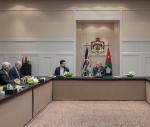You are here
The woes of Al Yemen Al Saeed
Nov 04,2018 - Last updated at Nov 04,2018
The situation in Yemen is too painful for words. It is a humanitarian catastrophe, according to the UNHCR, and experts fear that many more lives may be lost to violence, treatable illnesses or lack of food, water and shelter.
I acknowledge a personal emotional involvement because I had a Yemeni grandmother whose memory I cherish; but it is also difficult not to sympathise with a people whose modern history has been one tale of woe after another.
Yemen’s area is slightly more than 500,000 square kilometers, of which only 2.91 per cent is arable. Its GDP averaged $17 billion between 1990 and 2016, and it ranks 178th out of 189 countries in the UNDP Human Development Index. In other words, Yemen is one of the world’s 12 least developed countries.
But Yemen has natural resources, which include oil and natural gas reserves, fish and seafood and some mineral deposits. Its principal asset may be its location at the entrance to the Red Sea’s Bab Al Mandeb Strait, one of the most active and strategic shipping lanes; but I would argue that its greatest economic potential is tourism, particularly given the legendary generosity of Yemenis.
Tourists in Yemen used to pray to be kidnapped by tribesmen seeking to pressure the government into enacting or annulling some measure. People who were kidnapped told me that they were treated as honoured guests, with their captors competing to extend hospitality to them. They put on weight during their captivity.
It is painful to see a country that could have sustained itself from its limited resources, reduced to abject poverty and famine. And before we blame this on evil imperialist Zionist conspiracies, let us remember the role of flagrant corruption and bad government.
President Ali Abdullah Saleh maintained in the presidential palace for himself and his family an entire hospital manned by European medical and nursing teams, while the Yemeni people had a 60-year life expectancy at birth.
Consider also the Arab and Muslim world’s involvement in Yemen, from the first civil war (1962–1970), fuelled by the misadventures of Egypt’s Jamal Abdul Nasser, to the present war. During the past three years, Saudi Arabia invested an estimated $100 billion in the war, while Iran, which prefers to send its men (or Shiite refugees from Afghanistan) in harm’s way rather than use advanced technology, probably spent around $70 billion. For $170 billion you could have rebuilt Yemen brand new, even with a swimming pool.
Today, the photos of emaciated babies reduced to skin and bones should have shamed Yemeni leaders into seeking peace; but the obese Mohammad Al Huthi rejected the call for a ceasefire, being more interested in allocating blame for the war than in ending it.
The Yemeni people’s dearest ambition, as expressed by Yemeni Nobel Laureate Tawakkol Karman is “a future where my children feel safe, appreciated and proud to be who they are”.
It is tragic beyond words, when a country’s leaders are more interested in their PR than in ending the suffering of their people.












